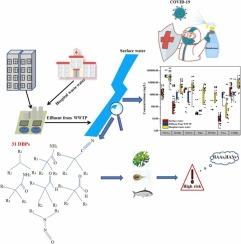当前位置:
X-MOL 学术
›
J. Hazard. Mater.
›
论文详情
Our official English website, www.x-mol.net, welcomes your
feedback! (Note: you will need to create a separate account there.)
Occurrence and ecological risk of disinfection byproducts in urban waterbody during the pandemic in the Pearl River Delta
Journal of Hazardous Materials ( IF 12.2 ) Pub Date : 2024-11-19 , DOI: 10.1016/j.jhazmat.2024.136550 Huazhi Wu, Lin Zhang, Pengran Guo, Yanping Zhao, Yumei Song, Xuerong Zhang, Yongqian Lei, Jingwei Xu
Journal of Hazardous Materials ( IF 12.2 ) Pub Date : 2024-11-19 , DOI: 10.1016/j.jhazmat.2024.136550 Huazhi Wu, Lin Zhang, Pengran Guo, Yanping Zhao, Yumei Song, Xuerong Zhang, Yongqian Lei, Jingwei Xu

|
As the economic center of southern China, the Pearl River Delta region (PRDR) pays special attention to public health issues. During the pandemic, intensive disinfection was carried out in the city to prevent the spread of the virus, which resulted in disinfectant residuals elevating and produced large amounts of toxic disinfection byproducts (DBPs) in the urban water environment. For the purpose of surveying the concentration and distribution of urban water DBPs during the outbreak, 57 samples were collected from three urban water matrices in the PRDR, and were analyzed for the common seven types of DBPs, to elucidate their occurrence and ecological risk. Total 31 DBPs were detected, and the average concentrations of various DBPs in the three matrices were in the order of: surface water (1.9-27.5 μg/L) < effluent from wastewater treatment plant (30.5-114.8 μg/L) < hospital wastewater (5.5-168.9 μg/L). Both trihalomethanes (THMs) and haloacetic acids (HAAs) were the two most major DBPs in all three water categories. By comparing the concentration levels of DBPs in different areas, the concentration levels of DBPs in PRDR were not high. In some hospital wastewater, the TOC content may be able to be used as an associative indicator of DBPs content. The results of the risk quotient indicate that HAAs and haloacetonitriles (HANs) pose some ecological risk.
中文翻译:

珠三角地区疫情期间城市水体消毒副产物的发生及生态风险
作为华南地区的经济中心,珠江三角洲地区 (PRDR) 特别关注公共卫生问题。疫情期间,该市进行了密集消毒,以防止病毒传播,导致消毒剂残留量升高,并在城市水环境中产生大量有毒消毒副产物 (DBP)。为了调查疫情期间城市水 DBP 的浓度和分布,从 PRDR 的 3 个城市水基质中收集了 57 个样本,并分析了常见的 7 种 DBP,以阐明其发生和生态风险。共检测出 31 个 DBPs,三种基质中各种 DBPs 的平均浓度依次为:地表水 (1.9-27.5μg/L) 废水处理厂出水 < (30.5-114.8μg/L) < 医院废水 (5.5-168.9μg/L)。三卤甲烷 (THM) 和卤代乙酸 (HAA) 是所有三个水类别中最主要的两种 DBP。通过比较不同地区 DBPs 的浓度水平,发现 PRDR 中 DBPs 的浓度水平并不高。在一些医院废水中,TOC 含量可能能够用作 DBP 含量的关联指标。风险商的结果表明,HAA 和卤代乙腈 (HAN) 构成一定的生态风险。
更新日期:2024-11-19
中文翻译:

珠三角地区疫情期间城市水体消毒副产物的发生及生态风险
作为华南地区的经济中心,珠江三角洲地区 (PRDR) 特别关注公共卫生问题。疫情期间,该市进行了密集消毒,以防止病毒传播,导致消毒剂残留量升高,并在城市水环境中产生大量有毒消毒副产物 (DBP)。为了调查疫情期间城市水 DBP 的浓度和分布,从 PRDR 的 3 个城市水基质中收集了 57 个样本,并分析了常见的 7 种 DBP,以阐明其发生和生态风险。共检测出 31 个 DBPs,三种基质中各种 DBPs 的平均浓度依次为:地表水 (1.9-27.5μg/L) 废水处理厂出水 < (30.5-114.8μg/L) < 医院废水 (5.5-168.9μg/L)。三卤甲烷 (THM) 和卤代乙酸 (HAA) 是所有三个水类别中最主要的两种 DBP。通过比较不同地区 DBPs 的浓度水平,发现 PRDR 中 DBPs 的浓度水平并不高。在一些医院废水中,TOC 含量可能能够用作 DBP 含量的关联指标。风险商的结果表明,HAA 和卤代乙腈 (HAN) 构成一定的生态风险。


















































 京公网安备 11010802027423号
京公网安备 11010802027423号